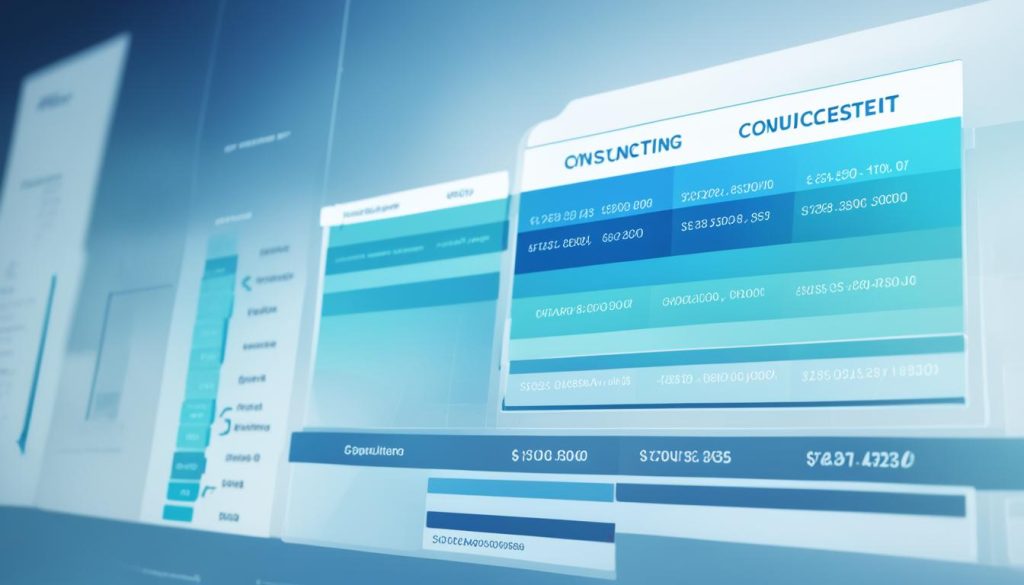Are you considering starting an IT consulting business? With the IT consulting industry generating a massive $640.1 billion in revenue in 2022, there couldn’t be a better time to enter this thriving market. In this article, we’ll guide you through the essential steps to launch your own successful IT consulting firm.
Starting an IT consulting business may seem daunting, but by following these steps, you can lay a strong foundation for your venture. From market research to building a business plan, deciding your pricing, registering your business, and managing your time, we will provide you with a comprehensive guide.
By the end of this article, you will have the knowledge and tools to set up your own information technology consultancy and start making a meaningful impact in the industry.
How to Start a IT Consulting Business?
Step 1: Market Research
Before launching your IT consulting business, conducting thorough market research is essential. This process involves gaining a deep understanding of your target market’s needs and identifying potential gaps that your business can fill. By analysing market trends and customer preferences, you can fine-tune your services and develop a competitive edge.
Start by identifying your target market—the specific group of clients you want to serve. Consider factors such as industry, company size, and geographic location. This will help you tailor your services to meet their unique needs and preferences.
Once you have identified your target market, the next step is to assess your competition. Analyse what your competitors are doing well and areas where their service may be lacking. This analysis will enable you to differentiate your business and identify opportunities for improvement.
One effective way to gather valuable insights is by conducting surveys or interviews with potential clients. This will allow you to gain direct feedback on their pain points and expectations. Additionally, you can leverage online tools and platforms to collect data on your target market’s preferences, purchasing behaviour, and online presence.
By conducting comprehensive market research, you will be equipped with the knowledge to make informed decisions and develop a robust marketing strategy. Understanding your target market and competition will enable you to position yourself effectively, create targeted marketing messages, and develop a marketing campaign that resonates with your audience.

Benefits of Market Research
- Identify target market needs and preferences
- Identify gaps in the market
- Analyse competition and differentiate your business
- Gain insights for developing marketing campaigns
- Make informed business decisions
Example Market Research Table
| Competitor | Strengths | Weaknesses |
|---|---|---|
| ABC Consulting | Strong reputation | High pricing |
| XYZ Solutions | Specialized expertise | Poor customer service |
| 123 IT Services | Competitive pricing | Limited service offerings |
Step 2: Decide the Type of Consultant Role
The type of consulting work you do will depend on your certification, experience, and skills. As an independent IT consultant, you have the flexibility to choose the type of consulting role that aligns with your expertise and business goals.
Types of IT Consultants
Consider the various types of consultant roles available:
- External Consultants: These consultants work on short-term projects for clients and provide specialized expertise in a specific area.
- Supplemental Consultants: These consultants work alongside the client’s internal team to provide additional support and expertise.
- Expert Consultants: These consultants are highly specialized in a specific IT field and offer their expertise to clients in short-term or ongoing contracts.
- Strategy Consultants: These consultants focus on helping clients develop long-term IT strategies and plans to achieve business goals.
- Technology Consultants: These consultants specialize in implementing and managing specific technologies or systems for clients.
- Security Consultants: These consultants focus on assessing and improving the security measures and protocols for clients’ IT infrastructure.
Consider your service’s key selling points and your areas of expertise when choosing the type of consulting work. Evaluate the demand for each type of consultant role in your target market to identify lucrative opportunities.
Choosing a Niche
While it’s essential to have a broad understanding of IT consulting, specializing in a niche can give you a competitive edge. Consider the following factors when selecting a niche:
- The demand for specific IT consulting services within your target market.
- Your personal interest and passion for a particular area of IT consulting.
- The potential for ongoing contracts and long-term client relationships in your chosen niche.
Focusing on a niche allows you to develop deep expertise, stand out from competitors, and attract clients who value specialized knowledge and experience.

| Type of Consultant Role | Main Focus | Engagement Model |
|---|---|---|
| External Consultants | Specialized expertise for short-term projects | Project-based |
| Supplemental Consultants | Additional support to client’s internal team | Project-based or ongoing |
| Expert Consultants | Highly specialized IT expertise | Short-term or ongoing contracts |
| Strategy Consultants | Developing long-term IT strategies | Ongoing |
| Technology Consultants | Implementation and management of specific technologies | Project-based or ongoing |
| Security Consultants | Assessing and improving IT security measures | Project-based or ongoing |
Step 3: Build a Business Plan
A solid business plan is key to the success of any new startup. It sets out what your business will do, how it will operate, and includes key findings from market research, company goals, resources needed, and the services provided. A well-crafted business plan provides direction, helps secure funding, and serves as a roadmap for future growth.
To build an effective business plan, start by organizing your research findings. Outline the current state of the market, including trends, opportunities, and potential competition. Identify your target market and clearly define your company’s unique selling proposition.
Next, establish your business goals and objectives. Determine what you want to achieve in the short term and long term. Specify key performance indicators (KPIs) that will measure your progress and success.
Consider the resources you’ll need to launch and operate your IT consulting business. This can include financial resources, such as startup capital, as well as physical resources like office space and equipment. Additionally, think about the services you plan to provide and how they align with your target market’s needs.
| Components of a Business Plan | Description |
|---|---|
| Executive Summary | A brief overview of your business, highlighting its unique value proposition and summarizing the key points of your business plan. |
| Company Description | A detailed description of your company, its mission, vision, and values. Discuss your target market and your competitive advantage. |
| Market Analysis | An analysis of your target market, including industry trends, customer demographics, and competitor analysis. |
| Products or Services | A description of the IT consulting services you will offer, including their features, benefits, and pricing. |
| Marketing and Sales Strategy | An outline of your marketing and sales approach, including your target audience, marketing channels, and pricing strategy. |
| Operations and Management | Details about how your business will be structured and operated, including information on key personnel and their roles. |
| Financial Projections | Projected financial statements, including income statements, cash flow statements, and balance sheets. |
| Implementation Plan | A timeline and action plan for executing your business strategies and achieving your goals. |
| Risk Analysis | An assessment of potential risks and challenges your business may face, along with strategies for mitigating them. |
Creating a business plan can be a complex task, but using a downloadable template can help simplify the process. There are many free business plan templates available online that you can customize to suit your specific needs.
Once your business plan is complete, review it regularly and make updates as needed. A well-maintained and evolving business plan will guide your decisions, help you stay focused on your goals, and increase your chances of success in the competitive IT consulting industry.

Step 4: Decide How Much to Charge
When starting your IT consulting business, one critical aspect that requires careful consideration is pricing your services. Determining the right pricing strategy is essential to ensure profitability while remaining competitive in the market.
To determine your pricing, several factors should be taken into account. Begin by evaluating the costs associated with running your business. Consider expenses such as software, hardware, licensing fees, office space, and employee wages, if applicable. These costs will help you establish a baseline for pricing your services.
Researching your competitors’ prices is also crucial in pricing your services appropriately. Analyze the rates charged by other IT consulting firms offering similar services in your target market. This information can give you insight into industry standards and help you position your pricing strategy accordingly.
Your experience and skills should also be factored into your pricing. As an IT consultant, your expertise has value, and clients are willing to pay for it. Highlight your qualifications, certifications, and years of experience to justify the rates you charge. Emphasize the unique value you bring to the table that sets you apart from competitors.
Once you have considered the various cost factors and analyzed the market landscape, you can decide on the pricing strategy that aligns with your business goals. Some consultants charge an hourly rate based on the time spent on a project or offer fixed-price contracts for specific deliverables. Others may opt for a retainer-based pricing model where clients pay a monthly fee for ongoing support and services.
It is vital to articulate your pricing and payment terms clearly in contracts with clients. This ensures transparency and prevents any misunderstandings down the line. Specify the agreed-upon pricing structure, payment frequency, and any additional terms regarding invoicing, late fees, or deposits.

By carefully considering the costs of running your business, conducting thorough competitor research, leveraging your experience and skills, and implementing a well-defined pricing strategy with clear payment terms, you can set your IT consulting business on a path to profitability while providing value to your clients.
Step 5: Register Your Business
To start signing contracts with clients, you need to register your business entity with state and local authorities. This ensures that your business is recognized as a legal entity, allowing you to operate and conduct transactions in accordance with the law.
Decide which business entity structure is best suited for your IT consulting business: sole proprietorship, partnership, or limited liability company (LLC). Each structure has its own advantages and considerations.
Sole Proprietorship
A sole proprietorship is the simplest and most common form of business ownership. In this structure, you are the sole owner and decision-maker of the business. You have complete control over the operations and bear all the legal and financial responsibilities.
Partnership
If you’re starting your IT consulting business with one or more partners, a partnership structure may be more suitable. A partnership allows for shared ownership and responsibilities among the partners. It’s important to have a written partnership agreement that outlines the terms and conditions of the partnership, including profit-sharing and decision-making processes.
Limited Liability Company (LLC)
An LLC is a hybrid business structure that combines the limited liability protection of a corporation with the flexibility and tax advantages of a partnership. Forming an LLC provides personal asset protection, meaning your personal assets are separate from your business liabilities.
Once you have decided on the business entity structure, check the availability of your business name. Conduct a search through the Companies House or relevant state business registrations to ensure your chosen name is not already registered by another business.
Next, complete the necessary documentation for the registration process. This typically involves filling out an application form and paying the required fees. Consult the specific guidelines and requirements outlined by the government department responsible for business registrations in your jurisdiction. Be prepared to provide information such as your business name, address, type of business entity, and details of the owners or partners.
| Business Entity Type | Advantages | Considerations |
|---|---|---|
| Sole Proprietorship | Simple to set up and operate | No separate legal entity, personal liability |
| Partnership | Shared ownership and resources | Joint and several liabilities |
| Limited Liability Company (LLC) | Personal asset protection | Formal administrative requirements |
Remember that different business structures have different tax obligations. Consult a tax professional or accountant to understand the tax implications and requirements for your chosen business entity.
Once your business is registered, you can proceed with confidence, knowing that you have fulfilled the necessary legal requirements and can focus on building and growing your IT consulting business.
Step 6: Manage Your Time Carefully
Effective time management is crucial for the success of your consulting business. As an IT consultant, you’ll have multiple tasks and responsibilities to handle simultaneously. To stay organized and productive, it’s important to prioritize tasks, set realistic goals, delegate and outsource when necessary, use productivity tools, and maintain a healthy work-life balance.
Prioritizing Tasks
Start by identifying the most critical tasks that need to be done. Prioritize them according to their urgency and importance. This will help you focus on what needs to be completed first and avoid wasting time on less essential activities. Consider using a task management tool or creating a to-do list to keep track of your prioritized tasks.
Setting Realistic Goals
When setting goals for your projects or consultancy, it’s important to be realistic and set achievable targets. Break down larger goals into smaller, manageable tasks and set a timeline for each. By setting achievable goals, you’ll maintain motivation and avoid feeling overwhelmed by unrealistic expectations.
Delegating and Outsourcing
Recognize that you can’t do everything yourself. Delegate tasks to team members or outsource certain activities to save time and focus on your core expertise. This allows you to leverage the skills and abilities of others while freeing up your schedule for higher-value tasks.
Using Productivity Tools
Investing in productivity tools can significantly enhance your efficiency. Consider using tools like project management software, time tracking apps, and collaboration platforms to streamline your workflows, improve communication, and track progress. These tools can help you stay organized, manage deadlines, and optimize your work processes.
Work-Life Balance
While building a successful consulting business, it’s important to maintain a healthy work-life balance. Dedicate specific time slots for work, breaks, and personal activities. Avoid overworking yourself, as this can negatively impact your productivity and well-being. Set boundaries by establishing clear working hours and prioritizing personal time, allowing yourself to recharge and maintain a healthy lifestyle.
Conclusion
Starting an IT consulting business is a journey that requires careful planning, thorough market research, and a solid business plan. By understanding your target market and choosing the right consultant role, you can position yourself for success in the industry. Additionally, setting competitive pricing, registering your business, and managing your time effectively are essential steps to ensure long-term growth and profitability.
Remember, success as an IT consultant goes beyond the initial setup. It’s important to continuously learn and adapt to the ever-evolving IT industry. Embrace new technologies, expand your skillset, and stay up-to-date with the latest trends. By doing so, you’ll remain ahead of the competition and better serve your clients’ needs.
In summary, starting an IT consulting business is an exciting opportunity for aspiring entrepreneurs. With the right approach and a dedication to continuous improvement, you can build a thriving consultancy that brings value to your clients and drives your own professional growth.
FAQs
What are different types of IT consultants?
Some types of IT consultants include external consultants, supplemental consultants, expert consultants, strategy consultants, technology consultants, and security consultants.
Why is a business plan important for an IT consulting business?
A business plan is important for an IT consulting business as it sets out what your business will do, how it will operate, includes key findings from market research, outlines the resources needed, and defines the services you will provide.
How can I effectively manage my time as an IT consultant?
To effectively manage your time as an IT consultant, you should prioritize tasks, set realistic goals, delegate and outsource when necessary, use productivity tools, and maintain a work-life balance.
How can I increase my chances of success as an IT consultant?
To increase your chances of success as an IT consultant, continuously learn and adapt to the evolving IT industry, understand your target market and competition, choose the right consultant role, set competitive pricing, register your business, and manage your time effectively.





